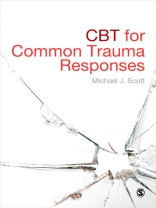This is the first book to show how to use cognitive behavioural therapy (CBT) with the full spectrum of post-traumatic responses; exploring how they affect and relate to one another. Focusing not only on co-morbidity with other anxiety disorders and depression, the book looks more widely at, for example, co-existing pain, substance abuse and head injury.
After discussing how to tailor CBT practice to work most effectively with trauma responses in real-world settings, Michael J Scott goes on to explore the step-by-step treatment of post-traumatic stress disorder, other commonly occurring disorders and, finally, secondary traumatisation. Those training to work with young people, or already doing so, will find the focus in Part Three on CBT with traumatized children invaluable.
Tabla de materias
Post-Trauma Responses and CBT – An Overview
PART ONE: POST-TRAUMATIC STRESS DISORDER
A DSM V-based CBT Model of PTSD
Assessment and Engagement
Non-trauma-focused CBT
Trauma-focused CBT
Group Treatment
Dual Treatment of PTSD with Commonly Associated Disorders
PART TWO: PRINCIPAL DISORDERS OTHER THAN PTSD
Sub-syndromal PTSD and Phobias
Prolonged Duress Stress Disorder
Chronic Adjustment Disorder
PART THREE: SPECIAL POPULATIONS
Working with Traumatised Children
Working with Traumatised Clients with a Severe /mental Illness
PART FOUR: SECONDARY TRAUMATISATION
The CBT Treatment of Pain and Disability
The CBT Treatment of Head Injury
The CBT Treatment of Disfigurement
Sobre el autor
Michael J Scott is a Consultant Psychologist specialising in the assessment and treatment of trauma and practising in Liverpool. This is his ninth text book and his books have included the Simply Effective CBT series and a self-help book for trauma victims and their friends and family, Moving On After Trauma. He taught CBT for 15 years at the University of Manchester and was External Examiner for the MSc in Cognitive and Behaviuoural Psychotherapies at the University of Chester. He is currently External Examiner at the Sheffield Hallam University.












